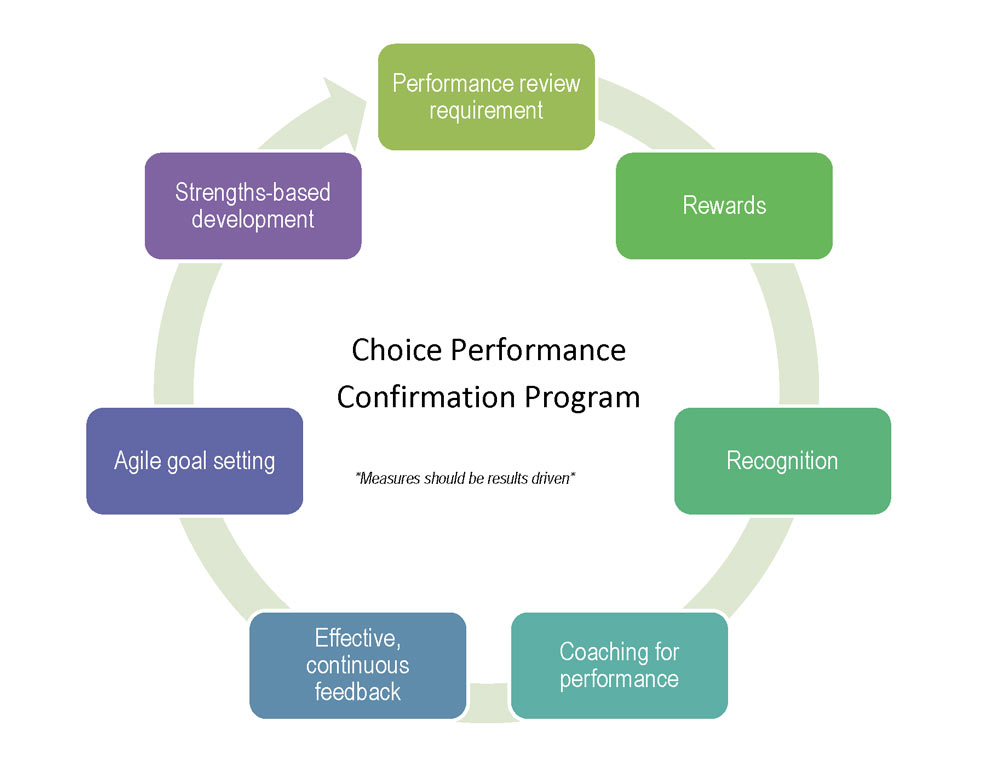Employee performance management
Employee performance management is both a process and a commitment to building a performance culture that:
- Links individual performance to organizational goals and performance measures.
- Ensures both the organization and its staff succeed in achieving business objectives.
- Promotes employee engagement, productivity, growth, and retention.
In This Section
Best practices make a performance culture visible and tangible
- Communication of executive commitment. The chief executive clearly communicates to all staff their commitment to the values of a high performing culture.
- Organizational performance management. The organization has a vision, a mission, and a strategic plan that has clear goals, objectives, performance measure and targets, and strategies.
- Performance planning. Organizational goals, objectives, performance measures and targets are cascaded through manager and employee performance plans and key results expected. Employee results expected are explained in measurable or observable terms. Benchmarks are communicated for both successful and outstanding performance. Individual development plans identify training and development needs and commitments.
- Performance coaching, feedback, and evaluation. Coaching and feedback are provided both when needed and at regular intervals.
- Corrective action and discipline. Using a systematic approach, underperforming employees are identified, corrected, moved to another position, or terminated.
- Recognition and reward. A process exists to distinguish, recognize, and reward employees who exceed performance expectations.
- Training and development. All supervisors receive initial and refresher training in employee performance planning, coaching, feedback, evaluation, corrective action and discipline, and recognition and reward. Employees are informed of the performance management systems, including the strategic plan’s goals, objectives, measures, and strategies.
- Management accountability. Performance plans, interim reviews, and evaluations are audited for both completion and quality.
- Employee confidence. A process exists to measure employees’ confidence in their personal connection to achieving organizational goals, supervisors’ investments in their success, management’s ability to effectively address performance problems, and management’s commitment to building and maintaining a performance culture.
- Resource allocation. The chief executive and senior leadership allocate sufficient resources (staff, budget, time) to successfully use all performance management systems, including individual development plans and performance awards.
Choice Performance Confirmation
Choice Performance Confirmation (CPC) is a performance management program, designed to:
- Assist state agencies in engaging and developing their employees
- Ensure agencies are aligned with standards and best practices before they are able to institute performance as a factor in leave
- Recognize agencies for the commitment they’re making to becoming an employer of choice
Interim reviews give supervisors opportunities to:
- Discuss progress.
- Provide support and resources.
- Adjust expectations.
- Reduce evaluation anxiety.
Employee development plans
For employees to succeed, they need to know what success looks like and receive regular coaching and feedback on their progress. The Performance and Development Plan (PDP) is a tool for facilitating communication between a supervisor and an employee about:
- The linkage between the employee’s expected results and the organization’s goals and performance measures.
- The employee’s standards and expectations.
- The organization’s commitments for training and development.
- The employee’s progress, accomplishments, and needs for growth.
The PDP is designed to facilitate both performance planning and feedback for a specific performance period. Each new employee should have a performance plan when he or she begins.
WAC 357-37-040 states that employers must use standardized PDP forms or alternate forms approved by the Assistant Director for State Human Resources. Please contact the State HR division of OFM at SHRPlanning@ofm.wa.gov for more information about approval of alternate PDP forms.
Performance issues
While employees experience many types of performance issues, most fall into one of three categories:
- Productivity (failure to meet timelines, quality standards, or production targets).
- Attendance (failure to come into work, coming in late, or leaving early).
- Conduct (failure to meet behavioral standards).
Performance usually becomes an issue when there is a pattern of unmet expectations. However, a single incident may be severe enough to merit disciplinary action.
Evaluations
- Begin with a strong performance plan. Include clear performance measures and update plans throughout the year as things change.
- Provide ongoing feedback. Ongoing feedback eliminates surprises in the evaluation, helps supervisors focus on supporting employees, and gives employees time to improve performance.
- Identify key issues/themes that need to be discussed. Give employees a draft evaluation with enough time to review and come prepared to the evaluation conference.
- Avoid surprises. The evaluation conference shouldn’t be the first time an employee hears about a performance problem or receives recognition for an accomplishment.
- Be specific. Clearly explain accomplishments and failures. Refer to the deliverables in the performance plan. Describe the impact of achievements or performance issues.
- Document both good and bad performance. Capture specific awards and commendation as well as corrective or disciplinary action and performance improvement plans. Make sure to evaluate the entire year, and avoid the ‘halo/horn effect’ of evaluating only the most recent performance.
- Focus on key deliverables and issues. Avoid details that don’t pertain to the employee’s performance.
- Be constructive. Focus on what the employee needs to do next to either develop knowledge and skills or improve performance.
Attendance issues
Employees are expected to take leave as needed to recover from illness, maintain work/life balance, and manage their health and other personal needs. But when a pattern of absences results in lost productivity, or impedes the work of others, attendance can become an issue. Attendance problems may show up as:
- Unauthorized or unscheduled absences.
- A pattern of before and after weekend absences.
- Tardiness and early departures.
- Long or frequent breaks.
- Excessive leave use, resulting in the need to take leave without pay.

![[See an accessible version of this diagram at: /sites/default/files/documents/WorkforceData/CPC/PMC_Pyramid.pdf]](https://ofm.wa.gov/sites/default/files/public/shr/WorkforceData/CPC/Bronze-Silver-Gold-Platinum-graphic.png)